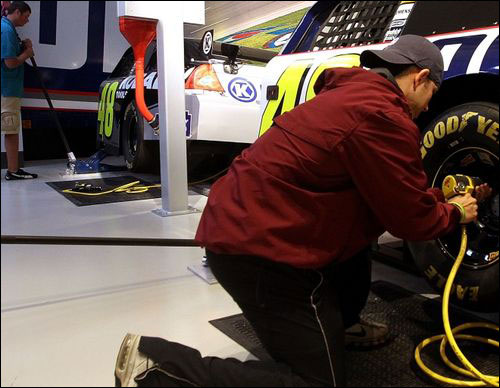The NASCAR Hall of Fame, located in Charlotte, N.C., has implemented RFID-enabled exhibits throughout its facility to offer visitors an experience they won’t soon forget. The 150,000-square-foot entertainment attraction, owned by the city of Charlotte and operated by the Charlotte Regional Visitors Authority under a license with NASCAR, gives fans a place to learn about stock-car racing’s colorful history. The exhibit’s designers, Ralph Appelbaum Associates, modeled the facility with interactivity in mind.
It all begins when visitors place a “hard card”—a credit-card-size plastic card embedded with a passive 13.56 MHz high-frequency (HF) RFID chip and antenna—on a turnstile to gain access to the exhibit hall. That same card activates exhibits at more than 75 kiosks around the facility. The card can be deactivated by tapping it on the reader at an exit turnstile, thereby killing the RFID chip within the card, as the visitor leaves through the turnstile. Deactivating the hard card’s RFID chip would prevent a patron from reusing the card to enter the Hall of Fame on another day, or from passing the card to someone else so that he or she could gain entrance without purchasing a ticket.

A visitor checks in upon arrival by tapping his or her hard card on the first kiosk, then picks a celebrity driver and fills out his or her name, thereby personalizing the experience as that person moves throughout the facility. Choosing Richard Petty, for example, allows the NASCAR legend to greet the visitor at each kiosk.
“The exhibits range from interactive trivia challenges to trying your hand at being a NASCAR inspector, where you inspect a car to make sure it’s safe for racing,” says Kevin Schlesier, the Hall of Fame’s exhibits manager. “We learned early on that artifacts and words can tell a great story, but there is so much to learn about NASCAR’s past and present that the best way to learn is by doing.”
Challenges get scored, and the system tracks each visitor’s progress. The RFID technology in the card ensures that the correct person receives the points saved in a database, routed by proprietary software from the kiosk to servers located in the company’s back room.
Visitors can take the card home as a souvenir, sign on to the Hall of Fame’s Web site, and enter a 12-digit serial number to view and download a list of all of their scores collected at each kiosk.
Electrosonic, an international audio-visual company specializing in AV systems integration and services, spent 18 months designing and building the system, which employs RFID hardware complying with the ISO 14443B RFID standard for passive HF tags. Originally, RFID Inc., a Colorado-based RFID systems provider, had designed a 125 kHz low-frequency (LF) reader for Electrosonic to install, because Ralph Appelbaum Associates required that the application for the 75 kiosks have a reader mounted on or near metal. The 125KHz system met the required read range and did perform favorably in tests. But in the end, the project leaders decided that it was best to adopt a 13.56Mhz solution that would be compatible with Ticketmaster’s ticketing/e-commerce solution.
Ticketmaster, also involved in the project, provided RFID-enabled point-of-sale (POS) payment devices based on the ISO 14443B RFID standard, to process purchases made with cash, as well as RFID-enabled credit and debit cards, such as those containing Visa payWave or MasterCard PayPass RFID chips. Ticketmaster controls purchases through the Hall of Fame’s box office, and wanted to use the RFID-enabled POS readers to activate the “hard cards.”
Having the RFID-enabled POS devices use the same sort of RFID technology employed by the Hall of Fame’s turnstiles and exhibits would provide complete integration throughout the facility. Therefore, RFID Inc. went back to the drawing board to develop an HF reader based on Ticketmaster’s specifications, along with a high-gain antenna.
There were a variety of challenges, says James Heurich, RFID Inc.’s president. For example, he explains, the USB repeaters that extend power to RFID readers across a longer distance didn’t work correctly; the repeaters made the readers lock up.
The exhibit’s designers had very specific requirements regarding how they thought visitors should place the card on the kiosk screen so that it could be read, says Bryan Abelowitz, Electrosonic’s sales engineer. Ralph Appelbaum Associates wanted visitors to place the entire card on the screen, but had to settle for half off and half on, due to technical challenges involving the readers’ inability to identify cards in the metal kiosks.
The readability issue required the team to develop a Plexiglas piece for the card to sit upon. This allowed Ralph Appelbaum Associates to successfully create the unique, high-tech customizable experience for visitors that it had hoped to achieve.

